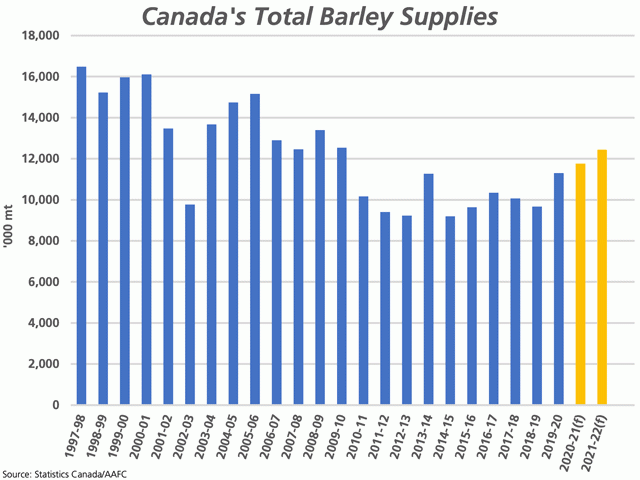Canada Markets
What Does the Latest Acreage Estimate Mean for Barley?
Statistics Canada's April 27 estimate for Canadian acres seeded to barley was based on March intentions of producers, which shows barley acres up 13.9% from 2020 to 8.613 million acres, above the upper-end of the range of pre-report estimates reported by Dow Jones that shows an expected of 7.7 ma to 8.5 ma.
While tight stocks along with attractive returns favor a move to barley, this expansion in acres could be challenged when producers hit the fields this spring. Statistics Canada's estimate for canola acres at 21.5 ma was at the lower end of pre-report estimates, a modest 3.6% increase despite record prices currently being reached. November canola has gained $67.70/metric ton so far this month, a considerable increase since the March surveys were conducted.
Since the Statistics Canada release, the November contract has fallen $11.20/mt, which signals a lack of concern and perhaps even a lack of confidence in the numbers. Pre-report estimates had pointed to the potential for canola acres to be reported as high as a record 23.2 ma, a forecast that would act to limit the upward move in barley acres.
P[L1] D[0x0] M[300x250] OOP[F] ADUNIT[] T[]
When Statistics Canada's acreage estimate is plugged into AAFC's current forecast for 2021-22, which includes a record-low carry-in of 500,000 mt, 91.8% of acres harvested, an average yield of 69.3 bushels per acre and imports of 60,000 mt, crop year supplies would rise by 5.7% year over year to 12.436 mmt. As seen on the attached chart, supplies would reach the highest level seen since 2009-10, or the highest in 12 years at 12.436 million metric tons. This volume would be 17% higher than the five-year average.
Demand remains a wildcard. When AAFC's domestic demand is left constant at 7.283 mmt for 2021-22, an estimated 5.153 mmt are available to meet export demand and grow stocks from the record low of 500,000 mt currently forecast for 2020-21.
The most recent AAFC forecast includes a 3.750 mmt export forecast for 2020-21, which is really a story of Chinese demand, with the Canadian Grain Commission reporting 94.6% of Canada's licensed exports in the August through March period destined for China. The current forecast would be the highest exports realized since 3.9 mmt was shipped in 2007/08 and 4 mmt shipped in 1996/97.
China has recently released plans to seek ways to reduce their reliance on corn over the upcoming crop year, with current forecasts from U.S. attache reports indicating a record 28 mmt to be imported in 2020-21. In order to reduce the need for imports in 2021-22, the country intends to increase the use of wheat, rice, rice bran, cassava, sorghum, barley, and oilseed meals in feed rations. This could result in even greater barley demand in 2020-21.
U.S. government forecasts for 2021-22 sends mixed signals. While the official estimate for China's 2020-21 corn imports is shown at 24 mmt, a recent attache report estimates this volume at 28 mmt, while lowering the 2021-22 imports to 15 mmt, clearing a path for competing products. At the same time, the same report forecasts barley imports for 2020-21 at 7.5 mmt, down from the official 8.3 mmt estimate, while imports in 2021-22 are to remain unchanged at 7.5 mmt.
The higher acres of barley will be viewed as a blessing for feed users in the crop year ahead, although the output potential will be watched closely and the competitive landscape experienced in 2020-21 between feed users and exporters will likely continue.
Cliff Jamieson can be reached at cliff.jamieson@dtn.com
Follow him on Twitter @Cliff Jamieson
(c) Copyright 2021 DTN, LLC. All rights reserved.






Comments
To comment, please Log In or Join our Community .